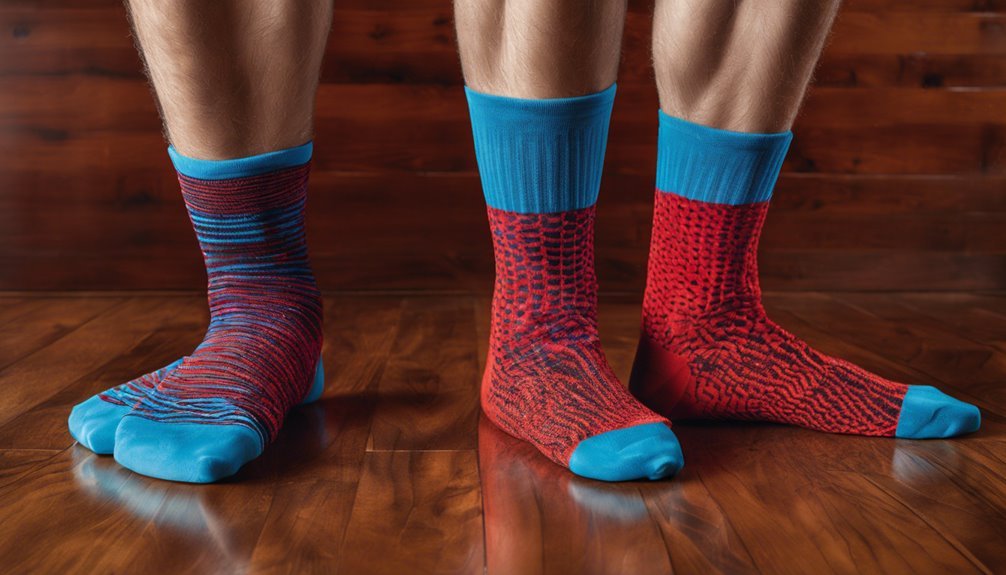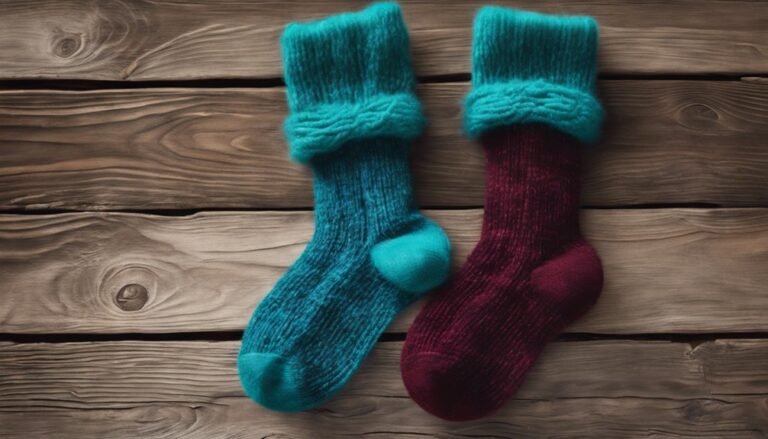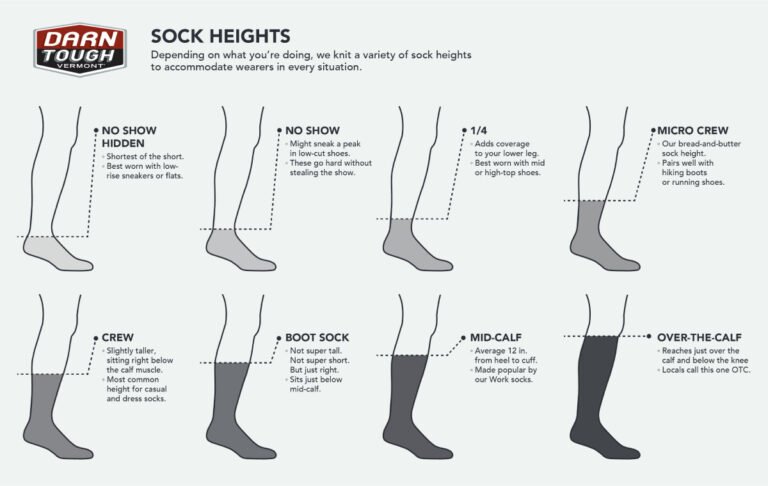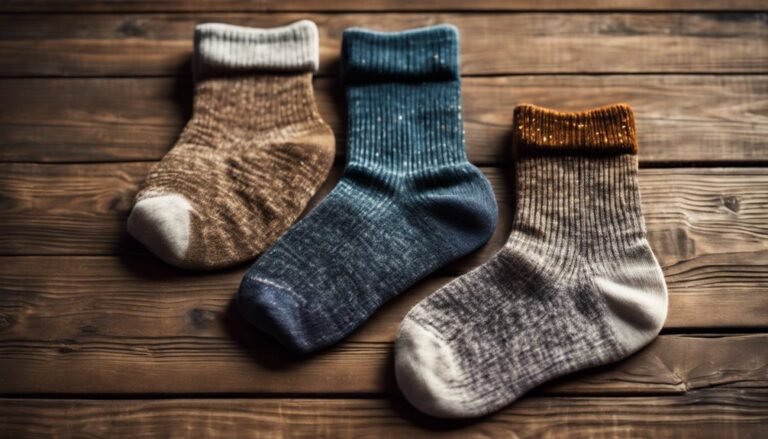Basketball Socks vs. Soccer Socks: Which Offers Better Grip?
When comparing grip in basketball and soccer socks, basketball socks typically offer better traction. They incorporate silicone or rubberized materials designed for quick lateral movements on hardwood surfaces. In contrast, soccer socks may feature grip patterns suitable for grass or turf but don't prioritize traction as much. Each sock is crafted to support the performance needs of its respective sport, influencing overall play. Exploring the specific design elements can provide deeper insights into their performance differences.
Understanding the Purpose of Sports Socks

When you think about sports, it's easy to overlook the role that socks play, yet understanding their purpose is essential for performance and comfort. Sock functionality varies greatly across different sports, as each has unique demands. For instance, basketball and soccer require distinct sock designs to meet sport-specific requirements. Basketball socks often incorporate cushioning for impact absorption and arch support, enhancing stability during rapid movements. On the other hand, soccer socks typically prioritize moisture-wicking properties and compression to maintain blood flow and reduce fatigue. Recognizing these differences allows you to choose the right socks, ultimately maximizing your athletic performance. By investing in sport-specific socks, you'll experience enhanced comfort and support, empowering you to perform at your best.
Key Features of Basketball Socks
Basketball socks are engineered with specific features that cater to the demands of the game. These socks not only enhance comfort but also greatly improve your performance on the court. Here are some key basketball sock features and their performance benefits:
| Feature | Performance Benefit |
|---|---|
| Moisture-Wicking Fabric | Keeps feet dry and comfortable |
| Arch Support | Reduces fatigue during play |
| Cushioning | Absorbs impact and enhances grip |
With these basketball sock features, you'll experience better support and reduced risk of injury. The right pair of socks can elevate your game, allowing you to focus on your performance without distractions. Investing in quality basketball socks is a smart choice for any player looking to maximize their potential.
Essential Elements of Soccer Socks
When considering soccer socks, you need to focus on material and design features that enhance performance. The right height and compression can greatly impact your comfort and mobility on the field. Understanding these essential elements can help you choose the best socks for your game.
Material and Design Features
Although soccer socks may seem like a simple accessory, their material and design features play an essential role in player performance and comfort. Typically made from a blend of synthetic fibers like polyester and nylon, these socks prioritize sock durability while maintaining breathability. The moisture-wicking capabilities keep your feet dry during intense gameplay, reducing the risk of blisters. With respect to design, many soccer socks feature strategic cushioning and reinforced toe and heel areas for added support. When you consider a performance comparison between soccer and basketball socks, the specific requirements of soccer, such as agility and foot movement, highlight the importance of these design elements. Ultimately, the right soccer socks can greatly enhance your on-field experience.
Height and Compression Benefits
While soccer socks may appear straightforward, their height and compression benefits are significant for enhancing athletic performance. The height advantages of these socks provide essential support to your calves, reducing the risk of muscle fatigue and cramping during play. The snug fit helps maintain blood circulation, which can be critical for stamina, especially in long matches. Additionally, the compression benefits stabilize your muscles, minimizing vibrations and potentially lowering injury risk. This combination allows you to maintain peak performance throughout the game. When you choose soccer socks, you're not just selecting a piece of gear; you're investing in your comfort and efficiency on the field. It's about maximizing your potential while enjoying the freedom of movement that ideal gear provides.
Materials Used in Basketball and Soccer Socks
When choosing between basketball and soccer socks, the materials used play an essential role in performance. You'll find that basketball socks often incorporate blends that prioritize cushioning and support, while soccer socks focus on moisture-wicking properties to keep your feet dry during play. Understanding these differences can help you select the right pair for your sport.
Sock Material Composition
The materials used in basketball and soccer socks play an essential role in enhancing performance and comfort on the field or court. Basketball socks typically feature a blend of cotton, polyester, and spandex, providing sock durability and a snug fit. This combination allows for flexibility while maintaining breathability, which is vital during intense games. On the other hand, soccer socks often incorporate nylon and elastic fibers, focusing more on lightweight construction and compression. This aids in reducing leg fatigue while promoting fabric breathability. The choice of materials influences how well each sock performs in its respective sport, ultimately affecting grip and traction. Understanding these differences can help you choose the right sock for your athletic needs.
Moisture-Wicking Properties
Moisture-wicking properties are essential for maintaining comfort during high-intensity activities like basketball and soccer. These properties play a critical role in moisture management, allowing sweat to evaporate quickly and keeping your feet dry. When you're on the court or field, breathability factors in your socks can greatly impact your performance.
| Sock Type | Material Used | Moisture Management |
|---|---|---|
| Basketball Socks | Polyester, Nylon | High |
| Soccer Socks | Merino Wool, Nylon | Moderate |
| Compression Socks | Spandex, Polypropylene | Very High |
Understanding these differences can help you choose the best socks for your needs, ensuring you stay focused on the game rather than discomfort.
Cushioning and Support
Cushioning and support are essential aspects of sock design that can greatly influence your performance and comfort on the court or field. Basketball socks typically feature thicker cushioning types around the heel and forefoot, providing shock absorption during jumps and quick movements. This extra padding helps minimize fatigue and enhances stability, important for high-impact play. In contrast, soccer socks often prioritize lighter cushioning, focusing mainly on the arch and ankle for support levels that allow for agility and speed on the field. The materials used, such as nylon and spandex blends, contribute to both durability and flexibility, catering to the specific needs of each sport. Ultimately, selecting the right sock can enhance your overall athletic experience.
Grip Technology in Basketball Socks

Many athletes may not realize the significant impact that grip technology can have on basketball performance. Basketball socks designed with innovative grip patterns provide traction enhancement that can improve stability on the court. These specialized designs often feature silicone or rubberized materials strategically placed to increase friction between your feet and the shoes, reducing slippage during quick movements. This can be vital during critical plays where every second counts. Additionally, effective grip technology helps maintain proper foot positioning, minimizing the risk of injury. By choosing socks that incorporate advanced grip features, you're not just enhancing your performance; you're investing in your overall game. Ultimately, the right socks can make a noticeable difference, allowing you to play with confidence and agility.
Grip Technology in Soccer Socks
When it comes to soccer performance, grip technology in socks is often overlooked but can make a significant difference on the field. Modern soccer socks integrate grip enhancement features and traction technology to improve stability and control. Whether you're pivoting, sprinting, or kicking, these advancements can help you maintain your footing.
| Feature | Description | Benefit |
|---|---|---|
| Silicone Grips | Applied on the inner cuff | Prevents slipping |
| Compression Fit | Tightens around the ankle and calf | Enhances blood flow |
| Moisture-Wicking Fabric | Keeps feet dry and comfortable | Reduces blisters and discomfort |
Which Sock Provides Better Grip for Performance?
Grip technology plays a pivotal role in enhancing athletic performance, but the effectiveness can vary considerably between basketball and soccer socks. When it comes to sock traction, here are three key factors to evaluate:
- Material Composition: Basketball socks often use a blend of materials for cushioning and grip, while soccer socks may prioritize breathability.
- Design Features: Basketball socks typically have targeted compression zones that enhance stability in sport footwear, whereas soccer socks focus on moisture-wicking and fit.
- Grip Patterns: The grip patterns on the soles of basketball socks can provide better traction on hardwood, while soccer socks may offer varying textures suited for grass or turf.
Ultimately, your choice depends on the sport you play and the specific performance needs you have.
Frequently Asked Questions
Can I Wear Basketball Socks for Soccer and Vice Versa?
You can wear basketball socks for soccer and vice versa, but consider sock material comparison and sport-specific features. Basketball socks may provide cushioning, while soccer socks offer compression and breathability, impacting performance in each sport.
How Do I Choose the Right Size for Sports Socks?
To choose the right size for sports socks, consult sizing charts based on your shoe size. Consider sock materials too; different fabrics may affect fit and comfort, impacting your overall performance during activities.
Are There Specific Brands Known for Better Grip Socks?
When seeking socks with superior grip, consider brands like Nike, known for their grip technology, and Adidas, which focuses on traction features. Both offer options designed to enhance performance and stability during various sports activities.
How Often Should I Replace My Sports Socks?
You wouldn't want your socks to become mere shadows of their former selves. To maintain sock durability and optimize performance impact, replace them every 6-12 months, or sooner if you notice wear or diminished comfort.
Do Grip Socks Work Better on Certain Playing Surfaces?
Grip socks can perform differently based on playing surface and sock material. For instance, smoother surfaces may benefit from specific materials designed for traction, while textured surfaces might require more grip to enhance your stability during play.







